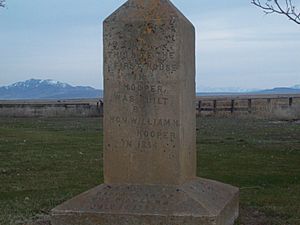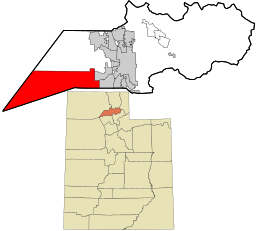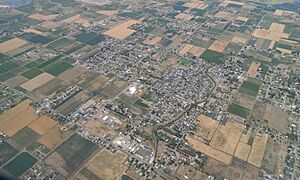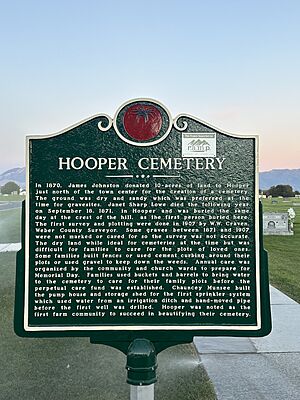Hooper, Utah facts for kids
Quick facts for kids
Hooper, Utah
|
|
|---|---|

Monument at the site of the first house built in Hooper in 1854
|
|

Location in Weber County and the state of Utah
|
|
| Country | United States |
| State | Utah |
| County | Weber |
| Settled | 1854 |
| Incorporated | November 30, 2000 |
| Founded by | William Henry Hooper |
| Area | |
| • Total | 87.99 sq mi (227.90 km2) |
| • Land | 26.10 sq mi (67.60 km2) |
| • Water | 61.89 sq mi (160.30 km2) |
| Elevation | 4,196 ft (1,279 m) |
| Population
(2020)
|
|
| • Total | 9,087 |
| • Density | 103.273/sq mi (39.8728/km2) |
| Time zone | UTC-7 (MST) |
| • Summer (DST) | UTC-6 (MDT) |
| ZIP code |
84315
|
| Area code(s) | 385, 801 |
| FIPS code | 49-36400 |
| GNIS feature ID | 2410790 |
Hooper (pronounced HOO-per) is a city located in Weber County, Utah, in the United States. It was first called Muskrat Springs. Later, it was named Hooperville after Captain William Henry Hooper, who was an early representative for Utah in the U.S. Congress. In 2020, about 9,087 people lived here.
Before it became an official city on November 30, 2000, Hooper was a "census-designated place" (CDP). This means it was a special area defined by the government for counting people, but it didn't have its own city government. Hooper is part of the larger Ogden–Clearfield, Utah Metropolitan Statistical Area.
Contents
Hooper's History: How It Became a City
Hooper was first settled by people in 1854. Many years later, in 1997, it became a "township." A township is a type of local government area. However, the township board found they couldn't make official decisions or changes.
Because of this, people in Hooper voted to become an official city. This vote happened on May 2, 2000. Hooper officially became a city on November 30, 2000.
Where is Hooper Located?
Hooper covers an area of about 11.7 square miles (30.3 square kilometers). Most of this area, about 11.5 square miles (29.9 square kilometers), is land. The rest, about 0.2 square miles (0.4 square kilometers), is water.
An interesting fact about Hooper's boundary is that it includes Fremont Island. This island is located in the Great Salt Lake. On March 30, 2007, Glenn Barrow, who was the mayor of Hooper at the time, became the first Hooper mayor to visit the island.
Who Lives in Hooper?
Hooper has grown quite a bit over the years. Here's how the population has changed:
| Historical population | |||
|---|---|---|---|
| Census | Pop. | %± | |
| 1880 | 849 | — | |
| 1890 | 778 | −8.4% | |
| 1900 | 886 | 13.9% | |
| 1910 | 823 | −7.1% | |
| 1920 | 859 | 4.4% | |
| 1930 | 911 | 6.1% | |
| 1940 | 1,020 | 12.0% | |
| 1950 | 1,243 | 21.9% | |
| 1990 | 3,468 | — | |
| 2000 | 3,926 | 13.2% | |
| 2010 | 7,218 | 83.9% | |
| 2020 | 9,087 | 25.9% | |
| 2023 (est.) | 9,369 | 29.8% | |
| Source: U.S. Census Bureau | |||
In 2020, there were 9,087 people living in Hooper. The city had about 192 people for every square mile. Most of the people living in Hooper were White (about 87.7%). About 7.9% of the people were of Hispanic or Latino background.
The population was almost evenly split between males and females. About 32.7% of the people were under 18 years old. The average age of people in Hooper was about 33.6 years.
Most households in Hooper (about 88.1%) were families. Many of these were married couples. Most homes (95%) were owned by the people living in them.
Fun Things to Do in Hooper
Hooper is well-known for its annual event called Hooper Tomato Days. This festival takes place every year from the last week of August through the first week of September. It also includes the Labor Day weekend.
More than 8,000 people attend this event each year. There are many fun activities for everyone. These include Horse Shows, Rodeos, Pageants, and Parades. You can also find vendor booths, lots of food, and fireworks. One of the most popular events is The Dog Race!
Long ago, Tomato Days celebrated the harvest of tomatoes grown by local farmers. While large tomato fields are less common now, the event still brings the farming community together for fun and celebration.
See also
 In Spanish: Hooper (Utah) para niños
In Spanish: Hooper (Utah) para niños



